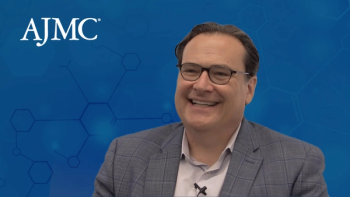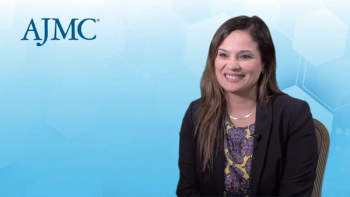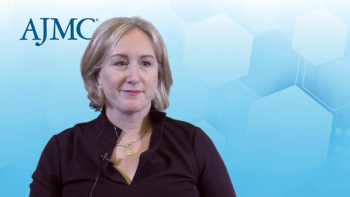
A high-dose influenza vaccine reduces the risk of death and incidence of hospitalization for influenza and pneumonia among older adults.

Laura is the vice president of content for The American Journal of Managed Care® (AJMC®) and all its brands, including Population Health, Equity & Outcomes; Evidence-Based Oncology™; and The Center for Biosimilars®. She has been working on AJMC since 2014 and has been with AJMC’s parent company, MJH Life Sciences®, since 2011.
She has an MA in business and economic reporting from New York University. You can connect with Laura on LinkedIn or Twitter.

A high-dose influenza vaccine reduces the risk of death and incidence of hospitalization for influenza and pneumonia among older adults.

The 1-year gap after the end of the Oncology Care Model (OCM) means some practices have to make hard decisions regarding cost of care or the financial health of the practice, explained Lalan Wilfong, MD, vice president of Payer Relations & Practice Transformation at The US Oncology Network.

Having a biosimilar on formulary makes it more likely the biosimilar will be adopted. Length of time a biosimilar is on market can impact how likely it is to be added to formulary.

Beyond smoking, the environment patients live in as well as their occupational risk factors all play large roles in the development of chronic obstructive pulmonary disease (COPD).

The FDA approved the first high-concentration adalimumab biosimilar. A low-concentration version of the biosimilar, Hadlima, was already approved. Both versions will launch in July 2023.

Adequate training will help physicians and researchers better address the needs of the communities they’re targeting, explained Vivienne Hau, MD, clinical assistant professor with the Kaiser Permanente Bernard J. Tyson School of Medicine.

While the Community Oncology Alliance (COA) was involved in humanitarian work in Puerto Rico after Hurricane Maria, the crisis in Ukraine caused COA to set up a special committee to jump into action, said Ted Okon, MBA, executive director, COA.

Results from DESTINY-Lung01 have shown promising progression-free survival and overall survival with ongoing research that may lead to a future FDA approval in non–small cell lung cancer (NSCLC), said Ticiana Leal, MD, associate professor, director of the Thoracic Medical Oncology Program, Department of Hematology and Medical Oncology, Emory University School of Medicine.

Insurance reimbursement for teleophthalmology services is not consistent among populations and only recently received a boost due to flexibilities allowed during the pandemic, said Parisa Emami-Naeini, MD, MPH, assistant professor of ophthalmology at University of California, Davis, and vitreoretinal surgeon and uveitis specialist at UC Davis Eye Center.

The Institute for Value-Based Medicine series visits Texas Oncology in Austin.

Despite the Hospital Transparency Rule being in effect, the majority of 340B hospitals are not reporting their prices for top services and drugs, and those that have, reported on “egregious” markups, said Ted Okon, MBA, executive director, Community Oncology Alliance.

A number of psychologic interventions were assessed to see if they could have an effect on patient confidence in biosimilars to treat psoriasis.

To ensure patients will use digital health solutions, they need to be at the table when these tools are being designed, said Amila Patel, PharmD, chief clinical officer, Navigating Cancer.

The single-center study evaluated patients across multiple cancers to understand the utilization, safety, and financial outcomes of bevacizumab-awwb vs reference bevavizumab.

The ruling by the Supreme Court on 340B reimbursements was narrow, but it sets up a future reimbursement reduction by HHS that is even greater based on survey data, said Ted Okon, MBA, executive director, Community Oncology Alliance.

There are some similarities among various value-based payment programs for cancer care, but they are not identical, said Susan Escudier, MD, FACP, vice president, value-based care and quality programs, Texas Oncology.

The involvement of pharmacy benefit managers (PBMs) in 340B is the “colliding of 2 worlds,” said Ted Okon, MBA, executive director, Community Oncology Alliance.

Although there is a paucity of data of switching among biosimilars of the same reference product, the few studies published support the safety and effectiveness of transitioning patients from one biosimilar to another.

Telemedicine visits can make physicians more efficient, but the ability to report symptoms can add to the workload burden as staff try to figure out which symptoms need to be addressed, said Susan Escudier, MD, FACP, vice president of value-based care and quality programs, Texas Oncology.

Getting a more diverse patient population in clinical trials may be as simple as including paperwork in more languages, but good training among investigators and study coordinators can help identify unconscious biases that may also have an impact, explained Vivienne Hau, MD, clinical assistant professor with the Kaiser Permanente Bernard J. Tyson School of Medicine.

Data presented at the American Society of Clinical Oncology annual meeting found non-White patients are less likely to receive immunotherapy for head and neck cancer, said Amila Patel, PharmD, chief clinical officer, Navigating Cancer.

Even though the Oncology Care Model (OCM) ended on June 30, 2022, there are some improvements that practices should continue implementing, said Susan Escudier, MD, FACP, vice president of value-based care and quality programs, Texas Oncology.

There was also an association between outpatient visit burden and comorbidities and the number of inflammatory upper airway diseases.

Navigating Cancer has found patients, including those who are elderly, are adopting applications to stay connected with their care teams, said Amila Patel, PharmD, chief clinical officer, Navigating Cancer.

As part of the investigation into pharmacy benefit managers (PBMs), the Federal Trade Commission (FTC) should delve into how PBMs are impacting and fueling drug prices and set up guardrails to protect Americans, said Ted Okon, MBA, executive director, Community Oncology Alliance.

In retina surgery, obtaining prior authorization is an extra burden, and a delay in treatment for some of these patients could mean loss of vision, said Sabin Dang, MD, ophthalmologist with The Retina Institute.

Understanding that patients who are HER2-low are different from patients who are HER2-positive and -negative means having the right way to evaluate and identify these patients, explained Debra Patt, MD, PhD, MBA, executive vice president of Texas Oncology.

The use of digital health solutions has been a tremendous benefit during the pandemic that should continue, said Susan Escudier, MD, FACP, vice president, value-based care and quality programs, Texas Oncology.

The budget allocates half of the money for the development of low-cost interchangeable insulin biosimilars and the other half for building an insulin manufacturing facility in the state.

Until recently, ophthalmologists in the United States have had no experience with biosimilars, despite the availability of biosimilars for bevacizumab, which is commonly used off label for ophthalmic conditions.

259 Prospect Plains Rd, Bldg H
Cranbury, NJ 08512
© 2025 MJH Life Sciences®
All rights reserved.
